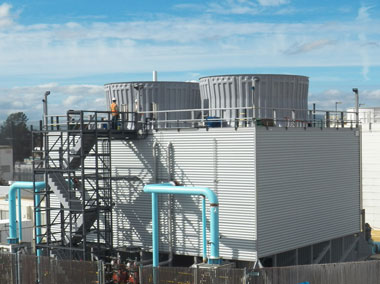Conducting safe, secure, and environmentally sound operations and modernizing the Laboratory’s infrastructure to meet evolving mission needs
Committed to the highest level of operational performance, Livermore employs best practices in environment, safety, and health (ES&H), and security. Management systems support continuous improvement in work practices. Prudent risk management coupled with active measures to prevent accidents ensures the safety of LLNL staff and the public. Investments are targeted to modernize Laboratory infrastructure.
Attention to ES&H
Continuous improvement is a key facet of Livermore’s Integrated Safety Management System and its Occupational Health and Safety Management System, which was re- certified this year under the Occupational Health and Safety Assessment Series (OHSAS) 18001 standard. LLNL’s injury and illness rates continued to fall and are near historic lows. FY 2017’s total recordable case (TRC) rate of 1.18 improves upon the previous year’s excellent performance, and the days away, restricted, or transferred (DART) rate, which is a measure of severity of injuries, is 0.44. Both figures are down by about a factor of two since the contract transition in 2008. LLNL’s Ergonomics Program, the Wellness Program’s annual Get Active campaign—and the Walking is Working campaign to reduce trips and falls—all contribute to employee health and safety. With many infrastructure improvement activities now in progress, construction safety is also a strong focus, and work was completed without any subcontractor safety incidents in FY 2017.
Effective Operations
In FY 2017, operations at LLNL were effectively and efficiently managed, with notable achievements in many areas. Importantly, Livermore is conducting innovative site planning, modernizing infrastructure, and meeting project planning goals (see Managing for the Future). LLNL also conducted well-managed business and financial operations. Nuclear Operations provided effective performance assessments, improved documentation related to Packaging and Transportation Safety, and supported Laboratory programs and other DOE sites in the areas of Nuclear Criticality Safety and Safety Basis.
In addition, the Laboratory’s Security Organization (SO) is revitalizing and modernizing LLNL’s physical security and protective force infrastructure. Construction of a new Protective Force Fitness and Training Center is ongoing and SO continues to make cost-effective improvements to enhance perimeter security. Employee security performance also has improved. A Security Culture Campaign helped to heighten awareness and engage employees regarding their security responsibilities and guided staff to adopt better practices.
A New Work-Planning Process
Implementation of the Laboratory’s revamped work planning and control (WP&C) process is well under way. This major undertaking is changing how mission, site-wide service, and facility and infrastructure work is planned, scheduled, and released. The new WP&C process is designed to ensure consistent Laboratory- wide practices, increase rigor and efficiency, and add value to work control documents. In FY 2017, all LLNL directorates began applying the new process to newly started work and major changes to existing projects. Feedback has been very positive. Each directorate has committed to a transition plan for all ongoing work projects, which are covered by more than 1,000 existing work control documents. A team from the DOE Office of Enterprise Assessments spent two weeks at the Laboratory in February 2017 assessing the new WP&C process. The team found no deficiencies and noted many of the new processes helped streamline work control.
Improvements in Site Sustainability
Environmentally responsible work practices are ensured by LLNL’s Environmental Management System, which has International Organization for Standardization (ISO) 14001 accreditation. These practices provide a systematic approach to identifying and reducing the environmental impact of Laboratory activities. Issued in October 2017, the 2016 Site Annual Environmental Report records LLNL’s compliance with environmental standards.
Overall, LLNL met its sustainability goals in FY 2016 and has already achieved its FY 2020 greenhouse gas reduction goal. Livermore is meeting California Governor Jerry Brown’s mandatory potable water irrigation reduction requirements. Since FY 2013, irrigation usage has been reduced by about 60 percent. However, the demand for cooling tower water (needed for supercomputing) remains substantial. A 10-acre 3.3-megawatt solar photovoltaic system located in LLNL’s northwest buffer zone is generating about 500 megawatt–hours per month to help meet goals for renewable energy use.
Maintaining the Infrastructure
LLNL invested nearly $33 million from the site support budget to improve the workplace environment. Some projects were real property replacements that benefit maintenance. Others improved laboratory spaces, expanded utilities, and contributed to site remediation. Investments included infrastructure improvements at Site 300 to ramp up for W80-4 life-extension program activities and supported construction of the Advanced Manufacturing Laboratory (see Managing for the Future). In addition, site demolition and site preparation of “Block 2200” readied the area for new construction to consolidate applied material and engineering activities at the Laboratory. LLNL is also poised to begin decommissioning and disposition of several contaminated legacy facilities.







